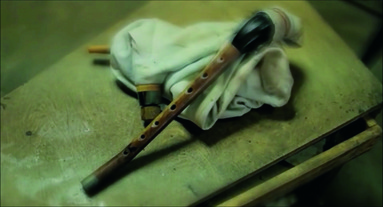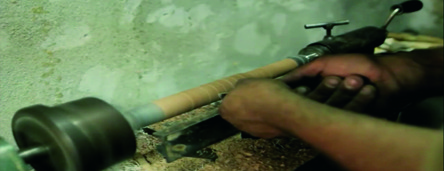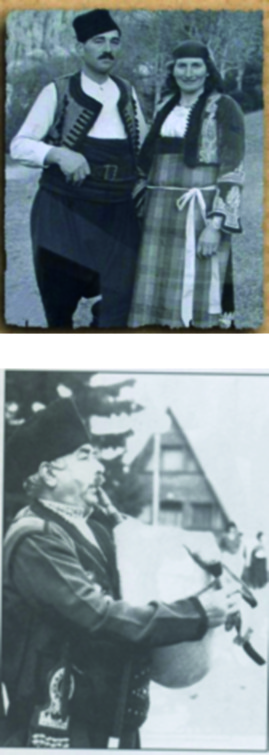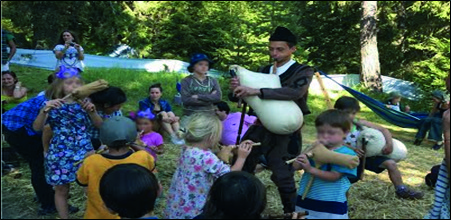The Bagpipe Society
The Kaba Gaida

The Kaba Gaida is a low pitched bagpipe which can be found in the Rhodope mountains in Bulgaria. It is a typical representative of the Gaida family and possesses all the characteristics - single drone, wooden chanter, flea hole, goat skin bag and a tube reed from elder, cane with a tongue, tight fingering style (each note is played by lifting only one finger). 60 years ago, the Kaba Gaida was not much different from the other gaidas (called Djura) in the region - high pitched, round chanters with horn at the end. Before 1961 there were mostly F to G kaba gaidas. After that year, appeared E and D kaba gaidas because of the rise of the amateur bands and the very famous ensemble “100 Kaba Gaidi”. Also, females choirs appeared which needed lower pitched gaidas. The horn on the Kaba Gaida was replaced by a curve at the end of the chanter and it was removed on the Djura Gaida.

The characteristics of the Kaba Gaida are:
- The key tone of Kaba Gaida is the tone produced when the index finger of the lower hand is up while the key tone of the Djura Gaida when lifting the small finger on the lower hand
- Kaba Gaida is low pitched. Mostly in E, but D and F gaidas are also in use. G pitched kaba gaidas are used by kids because the holes are closer to each other.
- The shape of the chanter is hexagon.
- Usually the bags of the Kaba Gaida are larger than those of the Djura.
- The shape of the chanter is curved at the end

Why Kaba Gaida has this special sound:
When Kaba Gaida starts to play, most people in Bulgaria feel strong emotions. The reason is that it is one of the few instruments that has managed to keep its original form from thousands of years, bringing ancient sound and tunes which touch the soul from the very deep down. That wonder is easily explained. Using natural materials and making style makes the gaida sounds close to the Nature and thus to the human hearts.

Probably the most distinctive characteristics of the Kaba Gaida is the type of reeds used. Djura gaida reeds are synthetic. Cotton phenolic material is used for the body of the reed and a clarinet type reed cut to size in order to fit the body. These type of reeds produce a louder sound and are not so sensitive to humidity and temperature changes. The Kaba Gaida reed is made from one piece of elder branch (normally 1-2 years old branches, gathered in the coldest days of the winter and dried for a year). The core is removed (it is naturally soft and easy to be taken out), the tongue is cut with sharp knife almost till the end of the reed but still the reed remains one whole piece of wood. Then cotton thread is wrapped tightly around for tuning purposes.
As Kaba Gaida makers say: “only Nature knows how the tongue will be cut”. It depends on how the wood, the finishing movement of the maker - and both of these are hard to predict. So we can say that Nature is deeply involved in the creation of the Kaba Gaida reeds. Since Nature is a primary source of quality, one-piece elder reeds sounds softly and produce sounds close to the sounds of the Nature. And those sounds are recognized by the deepest of our hearts.
The second secret of the Kaba Gaida is the balance between the sound of the chanter and the drone. The chanter should sound sharp while the drone should be soft. This balance is achieved with the combination of materials for the chanter and the drone. Thick and heavy woods (dogwood, boxwood) are used to make the chanter sound good while more soft woods like plum are used for the drone.

How Kaba Gaida preserved its form through the ages:
The Kaba Gaida is a traditional folklore instrument. The fact that the Rhodope region was relatively isolated meant that modernization came ever slowly, so that the Kaba Gaida remained unchanged in a lot of respects.
On the one side this is the way of making it: most of the makers still prefer traditional materials. On the other side it is the way it is taught: until recently it was the very traditional method that prevailed, a method based entirely on oral tradition, on hearing and watching performances of experienced masters and copying their style. The introduction of middle and high school musical education for folklore instruments in the ’70s changed the situation but even nowadays most people continue to learn the gaida in the traditional manner.
The different styles of playing the kaba gaida:
This way of passing down the Kaba Gaida led to the creation of different “dialects” in playing. In older days, the style differed not only from one region to another but also from one village to another. It was easy to say where a bagpiper comes from based on his style of playing. The local style was in some cases established based on the style of some famous player. For example, the well- known Kaba Gaida player Todor Shishkov from Solishta village influenced many famous musicians from the generation that followed him. In other cases the creation of a style was based on passing the tradition within the family. There are a lot of cases of families that have played the gaida for generations. The famous gaidar from Shiroka luka village Dimitar Grivnin even mentions that there were some “sitnezhi” (fast tunes) typical only for his family. (More on his story at http://tinyurl.com/zfwop2y). Also the sheer geographical isolation of regions and villages added for the consolidation of different styles.

Nowadays this stylistic richness steadily disappears as life has become more dynamic and communications easier and the style of playing more unified. Yet even so, there are Kaba Gaida players, including young people, who stubbornly cling to the so called “old time playing” which describes the more traditional style with its characteristic diversity and typical ornamentation. Giving time and geographical borders to different Kaba Gaida styles or categorizing them is a difficult task as what we know is based largely on oral tradition and older recordings. Widely accepted is the division between the style in the villages west of the nowadays town of Smolyan (Shiroka luka, Gela, Stoykite, the town of Devin) and those that lie to the east (Momtchilovtsi, Sokolovtsi, Polkovnik Serafimovo). There were differences in the repertoire. Some songs were more popular and subsequently more played in a certain region. There were differences in the interpretation of the songs. The manner of singing, the text and the melody of common songs varied a lot which contributed to differentiation of playing style. The most significant differences, however, concern the style of ornamentation, the true richness and uniqueness of Rhodope Kaba Gaida playing. The set of ornamentation used is largely the same but some ornaments are predominantly used in one style compared to the other.

According to old masters there was a distinct way of playing also in the town of Chepelare which lies north of Smolyan. Unfortunately there are no recordings which can testify for its characteristics.

Interesting style variations are noticed in the contact zones where Rhodope folklore met with other traditional folklore regions. On the border with the Thrace plain, in the villages lying on the outskirts of the Rhodope mountain, we see a great influence in the repertoire and the ornamentation from the Bulgarian Thrace folklore.
Maybe the most representative for the style west of Smolyan is the playing style that originates from the village of Gela and which is connected with the famous Kaba Gaida duo Dafo Trendafilov (http://tinyurl.com/z9gk5kt) and Mihail Kalfov (http://tinyurl.com/hpjmohp) . As both of them in a later age became teachers in the National School of folklore arts in the village of Shiroka luka, their style of playing became immensely influential for the younger generations of Kaba Gaida players. A good example for the “eastern” style are Lazar Kanevski (http://tinyurl.com/zhlrugk) from villiage Momtscilovsti and Stefan Zahmanov (http://tinyurl.com/j5587fq) from Sokolovtsi village as well as of Dimitar Petkovski whose recording with the singer Valya Balkanska (http://tinyurl.com/h9sx8wn) was sent into the space with the Voyager Mission. Georgi Markov (http://tinyurl.com/zovzmgk) and Georgi Musorliev (http://tinyurl.com/jm5yfup) are other examples of eastern style playing. Luckily the recordings of all these masters are more easily accessible online.
The Kaba Gaida today:
All Bulgarians know about Kaba Gaida, especially the fact that it is featured on the “Sounds of the Earth” record, now in space on the Voyager spacecraft, which describes the diversity of life and culture on Earth.
Ten years ago playing the instruments was a privilege for the people in the Rhodope mountains. When more and more pipers came to the capital Sofia (mostly to study), a couple of projects started to promote the instrument both on national and international level.
- Band Isihia. The band’s style unites elements of Bulgarian folklore and Hesychast Christian chant. They are actively touring worldwide. https://www.youtube.com/watch?v=Sg-hg1BG0aE
- Tupani i Gaidi. The band consists of couple of Kaba Gaidas, Australian didgeridoo and peruvian cajon. https://www.youtube.com/watch?v=MdJF7Xwd8e0
- http://www.KabaGaida.Com project consisting of training platform for beginners (Both in Sofia and online), managing the kaba gaida community worldwide, performing on the international stage with Kaynak Band (www.kabagaida.com/band) and playing “Gaida Games” educational concerts and workshops for kids and their parents.

In the next article*, the authors will reveal in details the ornamentation system for Kaba Gaida and will try to answer the people who ask “How the hell they do that?”!
About the authors
Cvetelin Andreev and Kostadin Gerdzhikov met in 2005 year and since then they are friends, play and teach gaida together. In 2012 they founded http://www.kabagaida.com. Kostadin has been playing the gaida since he was 10 years old. He was inspired to start by his cousin, Nikolay Belyashki, who is a renown gaida player and maker. The greatest musical influences upon him were his first teacher Kostadin Ilchev and the famous traditional players from the village of Gela. In 2014 he won the first price of the National Competition for kaba bagpipers in the village of Gela. For years he has been playing authentic folklore with different groups at festivals in Bulgaria and abroad.
Cvetelin has been playing the Rhodopean Kaba Gaida since 2005. He says he doesn’t remember how everything started. One day he was with his first gaida in front of his first teacher playing his first tunes in a small room in Sofia. Since then the gaida is always in his hands, mind and heart. In 2010 Cvetelin participated in the Danube Music Festival, and as first prize winner of the festival competition performing on Kaba Gaida, he has played with world-famous musicians like Carlos Nunes and Theodosii Spassov. For his initiatives he is recognized as a person who changes the social environment in Bulgaria in the “40 to 40, Darik” ranking for leaders under 40 years old.

- Data Processing Notice (GDPR)
-
@BagpipeSociety on X (formally known as Twitter)
-
TheBagpipeSociety on Instagram
-
 BagpipeSociety on Facebook
BagpipeSociety on Facebook
Something wrong or missing from this page? Let us know!
